Hiking Mount Moosilauke with a Rock in Hand: My “Rock” Climbing Trip Report
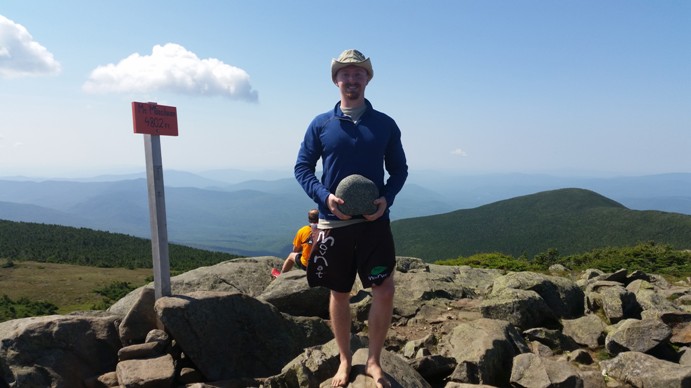
This is my rock. There are many like it, but this one is mine.
This past Saturday, I carried this rock up and down Mt. Moosilauke (4802′) in the White Mountains of beautiful New Hampshire with a group of men who were also crazy enough to carry their own rock’s up the mountain with me. I got the idea from a Navy SEAL prep school called SEALFIT that hosts a 50-hour version of hell week known as Kokoro. And so, when a friend of mine asked me to lead a hike up one of the White Mountains this summer, I just had to do it this way.
While I was researching which mountain we should climb, one of the locals who has climbed Moosilauke many times told me to allow a full day to climb this mountain – recommending a 12-hour time frame for the whole trip. Various hiking websites told us to plan on between 6-8 hours of hiking time for the route we’d be taking – rated as “difficult” and “moderately difficult,” depending on the website. We had a pretty fit group that had RSVPed. So, after comparing notes, I estimated that it would take us roughly 8-9 hours with the extra, unnecessary weight.
Of course, that’s not how it played out. In the end, we covered the ten miles in a little over 4 hours! Yes, I was amazed at how fast we did it. And yes, it was awesome.
You should really try it sometime, and here’s why.
Before the Hike
After arriving at our makeshift “base camp” the day before our hike, I headed down to the nearby Baker River to select a stone to carry. I had told the men earlier that, “special care should be taken when choosing a stone. It should neither be too big (perhaps revealing too much pride/ego) nor too small (perhaps revealing a lack of courage or ambition).”
So, when it was time to choose my stone, I pulled up to the river, walked down to the rocks, compared a few stones (I got the “pick of the litter!”), and chose this one.
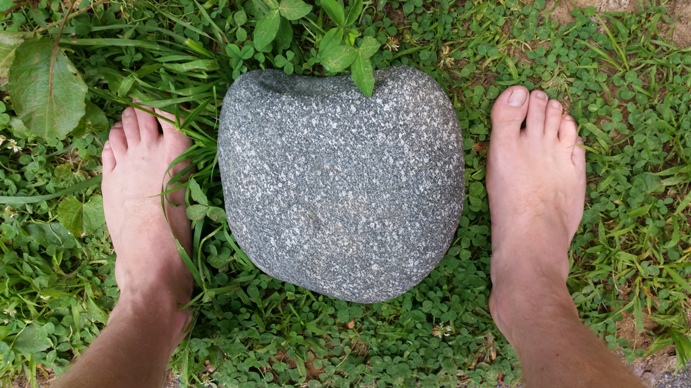
It only took a minute or two, which is probably a good thing since I was receiving unwanted attention from about 20 people who came there to swim.
Who is this guy and what the heck is he doing over there in the rocks all by himself? I’m gonna keep an eye on him (and they did!).
I didn’t want to overthink the process. So, I narrowed my selection down to three choices: a relatively small, medium, and large stone – all of them smooth as silk. And I chose this rock for three reasons…
- It’s purrrty.
- It has a notch that is perfect for carrying on a shoulder.
- The size and weight of this particular stone made me ever-so-slightly nervous.
I joked with the guys that I selected it because it was the darkest one of the bunch, but the real reason is that, for a split-second down by the river, I remembered a quote by Neale Donald Walsch:
“Every decision you make—every decision—is not a decision about what to do. It’s a decision about Who You Are.”
So, I just had to pick the biggest one, especially because the idea of carrying it all the way up the mountain made me uneasy. That’s just how I roll. I try to be intentional about seeking out challenges and getting of my comfort zone – for better or worse.
An important point is that I believed I could do it, but there was still some uncertainty about how hard it would be. So, I caught myself thinking…
Would I be the last guy to reach the top? Would I slow the others down (and not be able to effectively lead them)? How will my (bare) feet feel with the extra weight? Am I just showing off? Is this just my pride/ego getting the best of me?
But then I realized what these thoughts really were (i.e. fear), and decided that they would not influence my decision. So, I went with my gut feeling and chose the largest of the three. Why not? After all, it’s got a nice, pretty pattern to it. And I love nice, pretty patterns.
The morning of the hike, and before we departed for the trailhead, I held my rock for a little while – in much the same way that I carried it up the mountain – and I started to second-guess my decision. Maybe it was just my mind playing tricks on me, but it felt heavier than it did yesterday. Plus, I had only gotten four hours of sleep that night (don’t ask!). And so, I was already doubting myself before we even started!
I started thinking, “there’s no way I’m going to be able to carry this by hand all the way up.” What a wuss, right?
And when I think about it. That’s not me – never has been. And yet, here I was struggling with these self-defeating thoughts over a task that is well-within my ability to complete. I mean, come on, it’s just one mountain and a little extra weight. But that’s the power of the mind.
Eventually, I caught myself in the act and took those thoughts captive (I attribute my ability to do this, in part, to the mental training exercises I’ve learned in The Way of the SEAL, which has helped refine some of the mental toughness skills I’ve developed through physical training). So, I didn’t just think, I decided that I was going to carry this rock all the way up the mountain and then back down again – come hell or high water. What a difference a little mindset shift makes!
I also decided that I would carry my stone by hand up the mountain and in my pack down the mountain (a couple of us did it this way – others carried in their pack the whole time).
So, we set off for the trail, and quite honestly, the hike wasn’t all that different from most others I’ve done, except I was breathing a little harder, and I was a little less comfortable than usual because of the heavy object in my hands. I alternated between three carry positions: left shoulder, right shoulder, and a bear hug carry at waist level (i.e. biceps on FIYAH!).
So, everything was going great, and many-a-great conversation was had. But about three quarters of the way up, there was about 20 minutes when the hike got hard for me. Namely, my rock was getting heavy. My arms and shoulders were getting tired. My biceps felt like they were going to rip off my elbows. And my serratus anterior muscles (i.e. core musculature below the armpits, along the ribs) were not liking the alternating shoulder carries. At one point, it seemed like I was switching carry positions every 10-15 seconds, which was using up even more energy. I even bonked myself in the head once, which I later found out gave me a bloody ear – didn’t make that mistake twice.
It was probably because the grade was increasing and the footing was getting more technical – making it harder to stay upright and balanced with my rock since I was already a little fatigued. So, I was probably letting my movement get sloppy.
But it was just like any other “wall” that I’ve hit on a difficult hike, during a hard run, or when training. So, in that twenty minutes of difficulty, I just remembered my training these past 15+ years and I focused on putting one foot in front of the other with good technique. I didn’t think about how much further I had to go. I didn’t look up ahead. I kept my focus on the here and now. When I wasn’t chatting it up with my buddies, I was thinking…
I’m going to climb up this section, hop from here to there, maintain my posture, readjust the rock.
The wall lasted about 20 minutes or so, and ended when I was about a quarter mile from the summit. And before you knew it, our entire group was at the peak soaking in the view, cooling off in the breeze, eating, laughing, taking photos (no selfies for me!), and chatting with a few thru-hikers (the Appalachian Trail runs over this mountain). Our whole group finished within a few minutes of each other (I was impressed), and when we looked at the time, we realized that we did the 3.7 mile climb in just two hours, which included our 10 minute break.
We stayed at the top for about an hour – swapping snacks and chatting it up. And at one point while I was digging through my backpack, SOMEONE thought it would be funny to hide my rock on me.
I could’a sworn I put it right…(gasp) WHERE IS IT? MY BABY!
Note: it’s pretty hard to find a rock – even a rock as good-looking as mine – when you’re standing on top of a mountain-sized pile of rocks.
As you know, boys will be boys. And thankfully, the bandit returned the rock shortly thereafter, and I never let it leave my sight after that!
Here’s a single slice of our view from the summit:
And this is pretty much how I felt once we reached the top…
So, the hike was a complete success. Everything about it was perfect. The weather, the company, the journey – everything.
And the coolest part for me is that upon realizing how easily we all completed this hike, I’m left wondering how much of a heavier rock I could have carried up that day. Because when it comes down to it, I only really struggled for about 20 minutes. That’s it! And after all that mental jiujitsu I did earlier, too! And in hindsight, it wasn’t even that hard. I’ve worked much harder and struggled a lot more during some training sessions, races, and other competitions, among other things.
So, I can’t help but wonder, was there a larger rock in that riverbed that I could have used with much the same result? And how much bigger could I have gone? 1.5 times? Double? More? Could I have just-as-easily endured an hour of hard instead of just 20 minutes? How about a few hours? A full day?
I’ll never know. What I do know is that even after all that self-doubt in the beginning, I could have done so much more than I thought I could. And there’s the lesson.
The mind can both cripple you and enable you to do great things – things you may have once thought impossible. Henry Ford was right when he said, “whether you think you can or think you can’t, you’re right.” So was Napoleon Hill when he said, “whatever the mind can conceive and believe, it can achieve.”
And here’s the cool part for us fitness folks: the mind is a powerful tool that can be trained just like the body. But the only way to know what you’re really made of is to step up and do the hard stuff – that you think you might not be able to do. You have to test yourself, get out of your comfort zone, and keep stretching yourself well-beyond the point of difficulty. You have to set ambitious goals (that scare you a little) and risk failure. If you want to achieve great things in your health, fitness, or life, in general, you need to get comfortable with being uncomfortable. You have to seek out that 20 minutes of hard – whatever that means for you.
And here’s the good news…
Most people – myself included – have a tendency to grossly underestimate their potential, and particularly when it comes to fitness and performance. I’ve been training for over 15 years, and I still do it!
But time and time again, I’ve learned that in almost all cases, we can do so much more than we think we can.
And while I was up there on top of that mountain, I got a glimpse of the gap between the perception of my potential and my actual potential. And I’m willing to bet that most of the other guys did, too.
So, next time you go on a hike, consider bringing a big rock with you. Trust me. The extra weight is worth it.
You are capable of twenty times your perceived potential. – Mark Divine, Navy SEAL and founder of SEALFIT
If you enjoyed this post, please share it with your friends:
.jpg)
![]()
Health-First Fitness Coach
P.S. If you liked this post, then please signup for the newsletter, or follow me on Facebook or Twitter for daily updates and other interesting info.
P.S. I know of at least three people who were planning to join us “in spirit” and do their own rock carrying hike in different parts of the country. Anyone else?

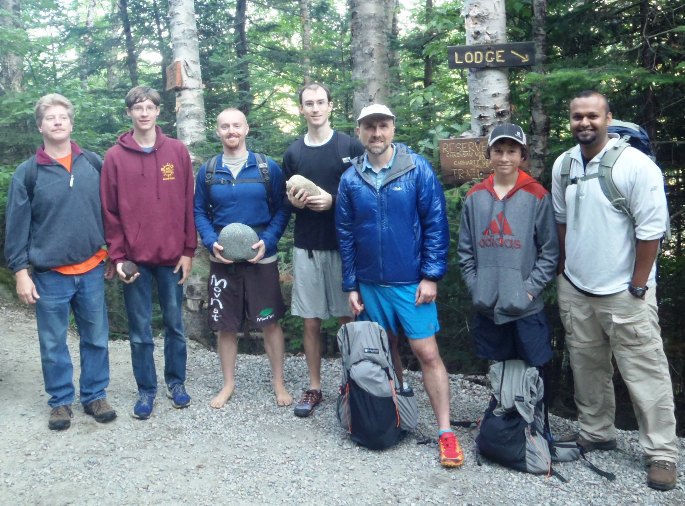
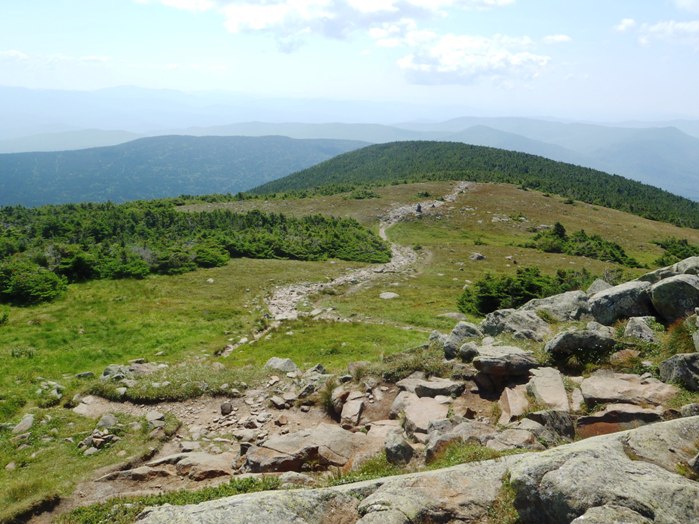
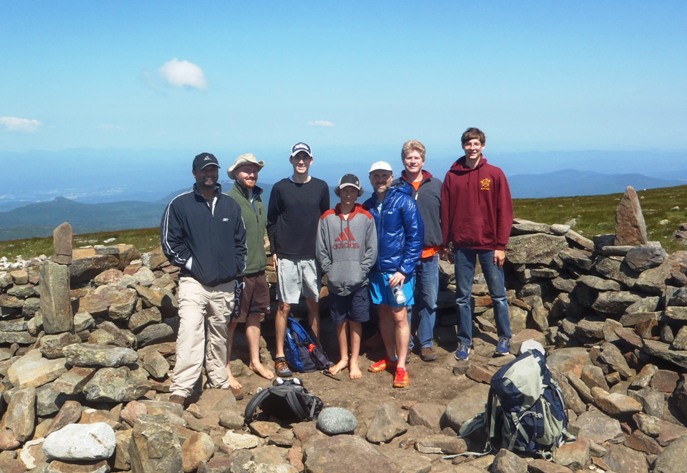
Nice. Sorry I had to bail, but I think I will follow on my own in a couple of weeks. After all, now that you guys have blazed the trail, it’s going to be so much easier for everyone who comes after. ;-)
You comment on an important effect of doing hard things. I have noticed that when I attempt and accomplish something that is difficult (and/or dubious) I find that it resets my default. For instance, when I thru-hiked the AT, I found that while I had once considered a 10 mile day to be a long day, I now consider it to be a fairly light day. 15 miles is now a decent day, with a proper day being 18-20.
This mental default is still in place (years later), even though I am no longer in fully forged hiking condition. So when I go hiking, I actually have to be careful and plan accordingly so my mental capacity doesn’t outrun my physical capacity. And of course, I have to adjust for the White Mountains, where miles follow similar principles to dog years.
The other part of this is the difference between what I can do feeling little effort, as opposed to what I can do with discomfort. We often let discomfort stop us from pushing our limits and resetting our defaults. Learning to recognize discomfort for what it is and managing it (as you did) is a huge part of training for anything.
Man, it sounds like it was an absolute blast. And…nice rock Dude.
Very good points, Dave – and all learned through experience because you’ve been willing to go the distance. I’ve noticed the same thing about my defaults getting reset with each new challenge and also having to be careful about not letting my mental capacity outrun my physical capacity.
Missed you, buddy. You would have loved the group we went up with. Next time!
And yeah, it is a nice rock, eh? I liked it so much, I brought it home with me. Not sure what I’m going to do with it yet, though.
Great post. Wish I could have been there (but I live in CA). Some of what you said I really need to take to heart, especially the bits about taking on something hard (or scary) and being willing to fail. And then learn from that. Last week with zero experience I went on an expensive guided hiking trip. Second night I had a panic attack. I ended up needing to leave the trip well before I intended. However, I learned a lot of things in that failure. I’m trying to let go of the money issues, and focus on the parts of the trip I really enjoyed, in the hopes I can better prepare for the next time. I also agreed to do a really hard bike race 1 year from now, that scares the hell out of me, but I have time to train and learn about my body, do test events, and come up with my strategies. And even if I fail, I think I will enjoy a lot and learn a lot.
You’ve got the right attitude, John. Sometimes, we get an unexpected wake-up call. I know I have! As long as you learn and grow from the experience (and clearly, you have!), then it was worth the money. No doubt you will learn a lot as you prepare and take on this bike race. Have fun.
Great job John. Tony Robbins says that perception is everything, how you perceive a situations is what is becomes. Mental as well as emotional was the easiest to master for me.
Thanks, Steve. True that!
“get comfortable with being uncomfortable” –> that’s a great quote
I always liked that one :)
Great accomplishment & great post, John. Love the rock of course. Looks like you hand selected a phorphyritic gabbro (granite with large crystals in a darker matrix). The larger crystals indicate a two-stage cooling process for the granite mass that this stone was eventually weathered from. Most interesting is your notch. No doubt your rounded stone was first shaped in the river bed or by the last passing glacier, but then became wedged firmly in a river pothole where scouring sand and gravel being carried by the current could work on just one exposed end, wearing at that portion and creating your unique notch. That’s the geology. I’ll let you apply your own symbolism to the points you presented above!
I will apply away! Thanks, Dennis.
I enjoyed your account, John. Did you weigh your rock when you got back home? I assume you kept it for future training.
BTW, traditional Chinese Martial Arts jiben gong (fundamental training) frequently utilizes rocks, and I’m planning to phase it in myself.
Thanks, William. I did bring it home with me and have used it a bit, but haven’t weighed it yet.
Thanks for this, was looking for an easy way out/carry tips, but instead got solid encouragement to just hand-carry two large deep cycle batteries for a solar panel up a mountain in the Panamanian Jungle.